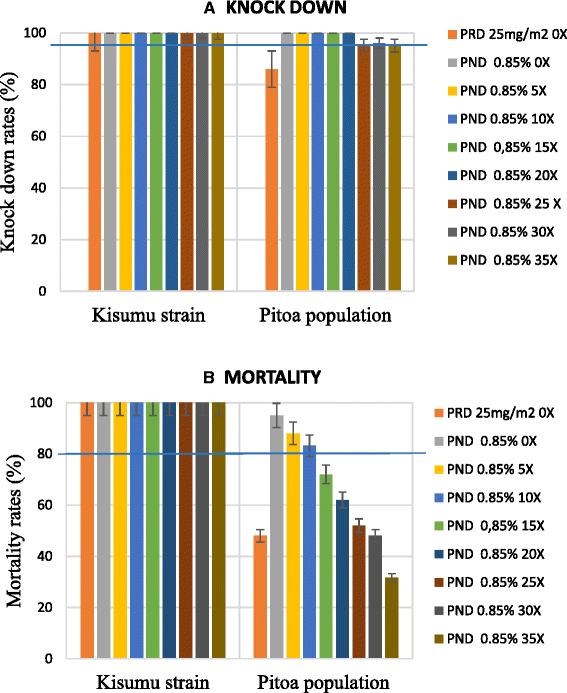When intensity of deltamethrin resistance in Anopheles gambiae s.l. leads to loss of Long Lasting Insecticidal Nets bio-efficacy: a case study in north Cameroon
- PMID: 26951758
- PMCID: PMC4782322
- DOI: 10.1186/s13071-016-1420-x
When intensity of deltamethrin resistance in Anopheles gambiae s.l. leads to loss of Long Lasting Insecticidal Nets bio-efficacy: a case study in north Cameroon
Abstract
Background: In Cameroon, insecticide resistance in Anopheles (An.) gambiae s.l. has been reported in several foci, prompting further investigations on associated patterns of Long-Lasting Insecticidal Nets (LLINs) bio-efficacy. The current study, conducted from June to August 2011, explored the intensity of deltamethrin resistance in An. gambiae s.l. from Pitoa and its impact on the residual bio-efficacy of LifeNet, a LLIN with deltamethrin incorporated into polypropylene nets (PND).
Methods: Two-four days old females An. gambiae s.l. reared from larval collections in Pitoa were tested for susceptibility to DDT, permethrin and deltamethrin, using standard World Health Organization (WHO) tube assays. Intensity of deltamethrin resistance was explored using WHO tube assays, but across six working concentrations from 0.001 % to 0.5 %. Bio-efficacy of unwashed and washed PND was assessed using WHO cone test. Species identification and kdr 1014 genotyping were performed on mosquito samples that were not exposed to insecticides, using PCR-RFLP and HOLA methods respectively. The Kisumu reference susceptible strain of An. gambiae s.s. was used for comparisons.
Results: A total of 1895 An. gambiae s.l. specimens from Pitoa were used for resistance and PND bio-efficacy testing. This mosquito population was resistant to DDT, permethrin and deltamethrin, with 18-40 min knockdown times for 50 % of tested mosquitoes and 59-77 % mortality. Deltamethrin Resistance Ratio compared with the Kisumu strain was estimated at ≥500 fold. LifeNets were effective against the susceptible Kisumu (100 % knockdown (KD60min) and mortality) and the resistant Pitoa samples (95 % KD60min, 83-95 % mortality). However, the bio-efficacy gradually dropped against the Pitoa samples when nets were washed (X (2) = 35.887, df = 8, p < 0.001), and fell under the WHO efficacy threshold (80 % mortality and/or 95 % KD60min) between 10 and 15 washes. The Pitoa samples were composed of three sibling species: An. arabiensis (132/154, 86 %), An. coluzzii (19/154, 12 %) and An. gambiae s.s. (3/154, 2 %). The kdr L1014F allele was found only in An. coluzzii (Npositive = 13/19), at 34 % frequency and heterozygote stage. No specimen carried the kdr L1014S allele.
Conclusions: The current study showed that LifeNet might still offer some protection against the resistant An. gambiae s.l. population from Pitoa, provided appropriate dose of insecticide is available on the nets.
Figures


References
-
- Glunt KD, Abílio AP, Bassat Q, Bulo H, Gilbert AE, Huijben S, Manaca MN, Macete E, Alonso P, Paaijmans KP. Long-lasting insecticidal nets no longer effectively kill the highly resistant Anopheles funestus of southern Mozambique. Malar J. 2015;14:298. doi: 10.1186/s12936-015-0807-z. - DOI - PMC - PubMed
-
- IRmapper. www.irmapper.com. Accessed 2 Aug 2015.
-
- Same-Ekobo A. Aspects épidémiologiques du paludisme au Cameroun. J Cam AcadSci. 2005;5(S1):3–16.
-
- MINSANTE . Plan stratégique National de lutte contre le paludisme au Cameroun 2011–2015. Cameroon: Ministry of Health; 2011.
Publication types
MeSH terms
Substances
LinkOut - more resources
Full Text Sources
Other Literature Sources
Molecular Biology Databases
Miscellaneous

